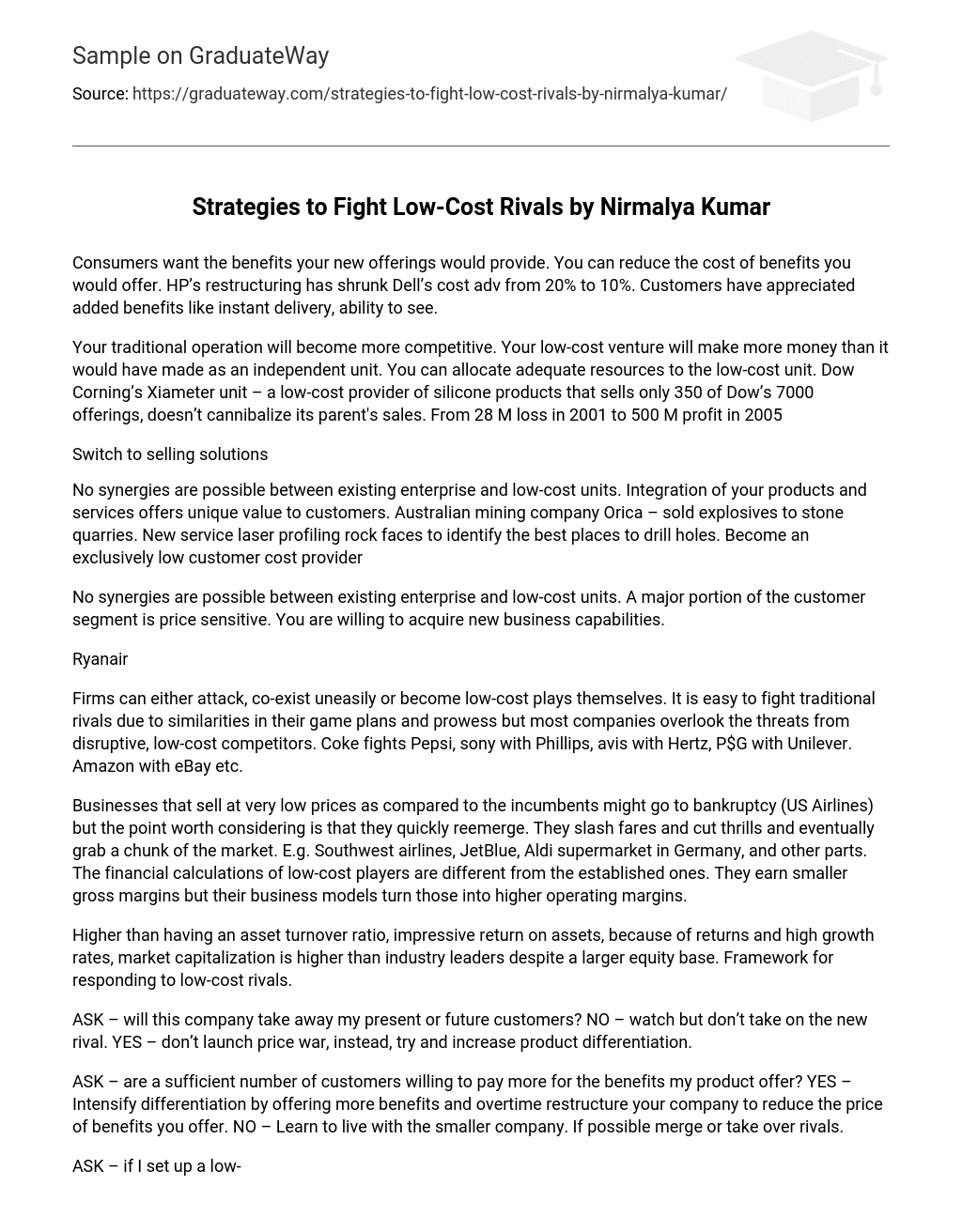Consumers desire the advantages that your new offerings would bring and are willing to pay for them. By reducing the cost of the benefits you plan to provide, you can attract more customers. HP’s restructuring has decreased Dell’s cost advantage from 20% to 10%. Customers have shown appreciation for additional benefits such as instant delivery and improved visibility.
Your traditional operation will become more competitive and your low-cost venture will generate more profits compared to operating independently. You will have the ability to allocate sufficient resources to the low-cost unit without negatively impacting the sales of the parent company. A prime example of this success is Dow Corning’s Xiameter unit, which specializes in affordable silicone products. Despite offering only 350 out of Dow’s 7000 product offerings, Xiameter managed to turn around a loss of 28 million in 2001 and achieved a staggering profit of 500 million in 2005.
Switch to selling solutions
No synergies can exist between current enterprise and low-cost units. The integration of your products and services provides customers with unparalleled value. Orica, an Australian mining company, sells explosives to stone quarries. They also offer a new service which involves laser profiling rock faces to determine optimal drilling locations. Embrace the role of being a low-cost provider exclusively for customers.
No synergies can be achieved between the existing enterprise and low-cost units, as a significant portion of the customer segment prioritizes price. However, you are open to the idea of acquiring new business capabilities.
Ryanair
Traditional rivals like Coke and Pepsi, Sony and Phillips, Avis and Hertz, and P&G and Unilever may easily compete with each other due to their similar strategies and strengths in the market. However, many companies underestimate the potential threats posed by disruptive, low-cost competitors such as Amazon and eBay.
Despite the potential for bankruptcy faced by businesses that offer significantly lower prices compared to their competitors, it is important to recognize that they also have the ability to quickly rebound. These companies reduce prices and minimize luxuries in order to gain a portion of the market share. Examples of such companies include Southwest Airlines, JetBlue, Aldi supermarket in Germany, and others. The financial strategies employed by low-cost players differ from those of well-established companies. Though they may earn narrower profit margins, their unique business models allow them to achieve higher operating margins.
Despite having a larger equity base, market capitalization is higher than industry leaders, as it has an impressive return on assets and high growth rates. Additionally, a framework is presented for responding to low-cost rivals.
ASK – is this company going to steal my current or future customers? NO – observe but do not engage in competition with the new rival. YES – avoid engaging in a price war, instead focus on enhancing product differentiation.
ASK – is there a satisfactory number of customers who are willing to pay a higher price for the benefits provided by my product?
YES – Enhance differentiation by offering additional benefits and gradually reorganize the company to lower the cost of the benefits offered.
NO – Adjust to operating as a smaller company. If feasible, contemplate merging with or acquiring competitors.
ASK – If I establish a low-cost business, will it create synergies with my current business?
NO – Convert to selling solutions or transform into a low-cost player.
YES – Counter your low-cost competitor by establishing a low-cost business.
Low-cost players in the market maintain their advantage due to favorable consumer behavior. The entry of new low-cost competitors poses a tougher challenge compared to traditional ones. For example, JetBlue’s entry is a particular concern for Southwest.
The Futility of Price Wars.
Despite market leaders imitating the key aspects of low-cost competitors’ business models, they are still unable to replicate their pricing. For instance, internet booking for airlines does not yield the same cost advantages for traditional airlines as it does for low-cost carriers. By reducing prices, leaders may decrease their profits but are unable to eliminate low-cost rivals from the market.
When Differentiation works: when leaders recognize that they cannot succeed in a price war, they choose to differentiate themselves.
Various methods of differentiation:
- Design cool products. e.g. – Apple
- Continually innovate. e.g. – Gillette, 3M
- Offer a unique product mix. e.g. – Sharper Image, whole foods. Brand a community. e.g. – Harley Davidson
- Sell experiences. e.g. – Starbucks, Nordstrom.
Differentiation is effective when:
Successful businesses do not solely rely on these tactics. Companies need to convince customers to pay for the advantages they offer. Companies should also align costs and benefits before implementing differentiation strategies.
Dealing with dual strategies
Companies should establish low-cost operations only when they can become competitive compared to traditional ones, resulting in new business opportunities and additional benefits that an independent unit would not have had. Examples of this strategy include First Direct and ING Direct. These low-cost business units should use a distinct brand name, similar to HSBC’s First Direct, and be housed separately as a subsidiary.
The effectiveness of a two-pronged approach depends on using a low-cost operation in an offensive manner to generate profits instead of using it purely defensively to harm competitors. A prime example of this is Dow Corning’s establishment of Xiameter.
Switching to Conquer
If traditional and low-cost businesses do not have synergy, there are two alternatives to handle competition from low-cost rivals: sell solutions, such as Orica’s blasting solutions, or become a low-cost player like Ryanair.





